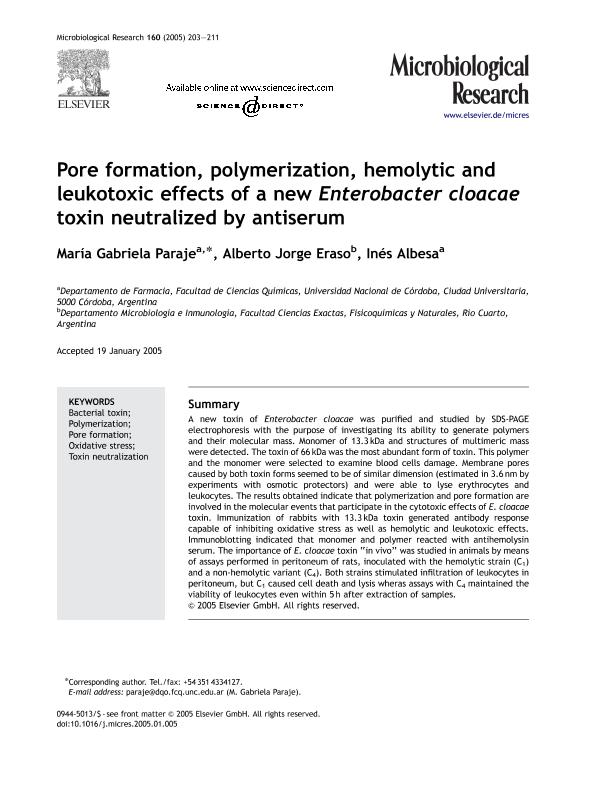Mostrar el registro sencillo del ítem
dc.contributor.author
Paraje, María Gabriela

dc.contributor.author
Eraso, Alberto Jorge

dc.contributor.author
Albesa, Inés

dc.date.available
2017-12-20T13:27:56Z
dc.date.issued
2005-04
dc.identifier.citation
Albesa, Inés; Eraso, Alberto Jorge; Paraje, María Gabriela; Pore formation, polymerization, hemolytic and leukotoxic effects of a new Enterobacter cloacae toxin neutralized by antiserum; Elsevier Gmbh; Microbiological Research; 160; 2; 4-2005; 203-211
dc.identifier.issn
0944-5013
dc.identifier.uri
http://hdl.handle.net/11336/31087
dc.description.abstract
A new toxin of Enterobacter cloacae was purified and studied by SDS-PAGE electrophoresis with the purpose of investigating its ability to generate polymers and their molecular mass. Monomer of 13.3 kDa and structures of multimeric mass were detected. The toxin of 66 kDa was the most abundant form of toxin. This polymer and the monomer were selected to examine blood cells damage. Membrane pores caused by both toxin forms seemed to be of similar dimension (estimated in 3.6 nm by experiments with osmotic protectors) and were able to lyse erythrocytes and leukocytes. The results obtained indicate that polymerization and pore formation are involved in the molecular events that participate in the cytotoxic effects of E. cloacae toxin. Immunization of rabbits with 13.3kDa toxin generated antibody response capable of inhibiting oxidative stress as well as hemolytic and leukotoxic effects. Immunoblotting indicated that monomer and polymer reacted with antihemolysin serum. The importance of E. cloacae toxin "in vivo" was studied in animals by means of assays performed in peritoneum of rats, inoculated with the hemolytic strain (C1) and a non-hemolytic variant (C4). Both strains stimulated infiltration of leukocytes in peritoneum, but C1 caused cell death and lysis wheras assays with C4 maintained the viability of leukocytes even within 5 h after extraction of samples.
dc.format
application/pdf
dc.language.iso
eng
dc.publisher
Elsevier Gmbh

dc.rights
info:eu-repo/semantics/openAccess
dc.rights.uri
https://creativecommons.org/licenses/by-nc-sa/2.5/ar/
dc.subject
Bacterial Toxin
dc.subject
Polymerization
dc.subject
Pore Formation
dc.subject.classification
Otras Ciencias Químicas

dc.subject.classification
Ciencias Químicas

dc.subject.classification
CIENCIAS NATURALES Y EXACTAS

dc.title
Pore formation, polymerization, hemolytic and leukotoxic effects of a new Enterobacter cloacae toxin neutralized by antiserum
dc.type
info:eu-repo/semantics/article
dc.type
info:ar-repo/semantics/artículo
dc.type
info:eu-repo/semantics/publishedVersion
dc.date.updated
2017-11-16T15:17:59Z
dc.journal.volume
160
dc.journal.number
2
dc.journal.pagination
203-211
dc.journal.pais
Alemania

dc.description.fil
Fil: Paraje, María Gabriela. Consejo Nacional de Investigaciones Científicas y Técnicas. Centro Científico Tecnológico Conicet - Córdoba. Instituto Multidisciplinario de Biología Vegetal. Universidad Nacional de Córdoba. Facultad de Ciencias Exactas Físicas y Naturales. Instituto Multidisciplinario de Biología Vegetal; Argentina. Universidad Nacional de Córdoba. Facultad de Ciencias Químicas. Departamento de Farmacia; Argentina
dc.description.fil
Fil: Eraso, Alberto Jorge. Universidad Nacional de Río Cuarto. Facultad de Ciencias Exactas Fisicoquímicas y Naturales; Argentina
dc.description.fil
Fil: Albesa, Inés. Universidad Nacional de Córdoba. Facultad de Ciencias Químicas. Departamento de Farmacia; Argentina
dc.journal.title
Microbiological Research

dc.relation.alternativeid
info:eu-repo/semantics/altIdentifier/url/https://www.sciencedirect.com/science/article/pii/S0944501305000145
dc.relation.alternativeid
info:eu-repo/semantics/altIdentifier/doi/https://doi.org/10.1016/j.micres.2005.01.005
Archivos asociados
